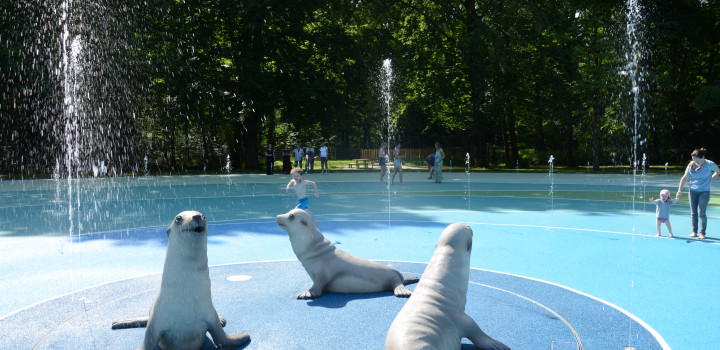The first known wide spread European culture of modern man is the "Aurignacian". About 35.000 years ago these people were creating what is considered to be the oldest art known to mankind. Detailed knowledge of wildlife, the behaviour and physiognomy of the animals, was most vital for our ancestors to survive. The artwork discovered at the Vogelherd-Cave in the Swabian Alb as well as the paintings found in caves in the French Pyrenees indicate that there has been a cultic veneration of animals.
At the Archäopark visitors can explore our ancestors way of life as well as their special relationship to animals. Yet there will be no "picture show", visitors won't find just illustrations, neither of the animals, people nor of the landscape of that era. By means of hints, traces, sounds and silhouettes visitors of all ages will be enabled to create their own image, experiencing the site with all senses.
A glass foyer allows visitors to get an overview of the exhibition area and the archaeological theme park even before entering the building. At first glance the sites spatial context can be realised. From here, a gently sloping gravel lawn unfolds downwards to the foot of the Vogelherd hill, becoming a circular square in front of the building. A circuit leading to the Vogelherd hill frames the square. At the northern and southern flanks of the building the terrain gently ascends, covering the crescent-shaped exhibition area opposite of the entry of the cave. As a result, the building will only be visible from its western side.
Soon after leaving the building and entering the inner square, sound installations set visitors back in the time of the mammoth hunters, evoking instincts and emotions as well as inspiring their curiosity. Audiobeams, integrated in the framing wall of the square, concentrate sounds to particular points. Being sensitised, visitors become aware of so called "audio holes" inside the concrete wall. They inspire to listen attentively.
Along the circuit wooden planks turn up in irregular intervals bearing inscriptions, showing a wide range of thesis on and questions about palaeontology. In contrast to the precise informations given inside the information center, these "unclosed files" demonstrate the influence of our ancestors up to our nowadays life. Further references and explanations can be found left and right of the path, placed on black blocks made of natural rubber (caoutchouc). Visitors can pick up informations here like collecting berries.
The circuit with its water-bound surface is lifted above ground level inside the protected zone by backfilling the base course. The edges aren't precise but merge into the surrounding terrain - depending on the level of utilisation. Herbs, grasses and former crop plants accompany the circuit, representing a variety of plants playing an important role in the life of our ancestors.
Traces of animals which lived in the region during the glacial period arise irregulary, crossing the circuit and vanishing again into the landscape, appealing the hunter's instinct. Visitors are seduced to trail the tracks. To preserve these prints and to keep the ground permeable at the same time, a special mixture of gravel, sand and cement is used.
Downhill of the Vogelherd cave, visitors pass through a herd of mammoths. The wire sculptures give an impression of the enormous size of these extinct animals, and how dangerous it must have been to hunt them, in particular with only the simplest weapons available. Additional information about the behaviour of the mammoths, possible hunting methods and the different theories why these impressive animals have disappeared is placed alongside the pathway.≈
Archäopark Vogelherd
New archaeological museum and park
Client
- Gemeinde Niederstotzingen
Project Data
- Competition: 2011, 1. Preis
Project Team
- Ritter Jokisch Architektur Innenarchitektur München
- Lutzenberger & Lutzenberger, Bad Wörishofen
Year
2011
Location
Niederstotzingen





















